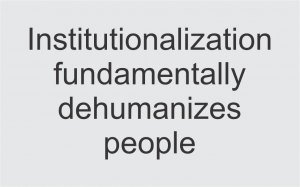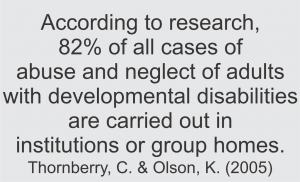Say “NO” to Congregated Settings,
Say “YES” to Human Rights!
Recognizing the right to live in the community is about enabling people to live their lives to their fullest within society and access the public sphere, including “small places, close to home.” It is a foundational platform for all other rights: a precondition for anyone to enjoy all their human rights is that they are within and among the community.
 The right to live in the community is closely linked with fundamental rights such as personal liberty, private and family life, and freedom from ill-treatment or punishment. Three key elements are choice; individualized supports that promote inclusion and prevent isolation; and making services for the general public accessible to people with disabilities.
The right to live in the community is closely linked with fundamental rights such as personal liberty, private and family life, and freedom from ill-treatment or punishment. Three key elements are choice; individualized supports that promote inclusion and prevent isolation; and making services for the general public accessible to people with disabilities.
This right is violated when people with disabilities who need some form of support in their everyday lives are required to relinquish living in the community in order to receive that support; when support is provided in a way that takes away people’s control from their own lives; when support is altogether withheld, thus confining a person to the margins of the family or society; or when the burden is placed on people with disabilities to fit into public services and structures rather than these services and structures being designed to accommodate the diversity of the human condition.
 Placement in institutions is a pervasive violation of this right which calls for a firm commitment to deinstitutionalization. Many more are isolated within their own communities due to inaccessibility of facilities such as schools, health care, and transportation and lack of community-based support schemes.
Placement in institutions is a pervasive violation of this right which calls for a firm commitment to deinstitutionalization. Many more are isolated within their own communities due to inaccessibility of facilities such as schools, health care, and transportation and lack of community-based support schemes.
Revealing the various ways in which this right is violated is essential to ensure that one form of exclusion and segregation, such as institutionalization, is not replaced by another form, such as other, even if smaller, frameworks of congregate care. Creating an alternative in the form of support services that do not enable choice or interaction with the community does not amount to implementing this right either. (Adapted from The right of people with disabilities to live independently and be included in the community Issue Paper: Council of Europe Commissioner for Human Rights 2012)

Congregated Settings decrease quality of life outcomes:
-
-
-
- Create Public Health Concerns
-
-
- Long-term-care facility deaths made up over a third of all US deaths based on COVID Tracking Project (CTP) data)
-
-
- Limit Autonomy & Freedoms
-
-
- Individuals have less freedom to make, carry out, and implement choices.
- Limits to what, where, who, and when activities and relationships can occur
- fixed timetables/system rules
-
-
- Lack Privacy
-
-
- sharing of bedrooms, bathrooms, & common areas
- little personal space
-
-
- Lead to a loss of identity and change in social status
-
-
- Cannot pursue personal interests
- limits on personal possessions
-
-
- Reduce social participation in the larger community
- Increase rates of abuse and neglect
-
-
- Institutions are inherently susceptible to situations of abuse due to the disempowered state of individuals living within the system, their own fear of retribution borne out of their dependency on the system for basic support, the lack of access to justice, and disability-related communicational barriers
-
-
- Decrease individual attention
- Staff values dependent behaviors and compliance above independence.
- Create Public Health Concerns
-
-
 Besides violating human rights, health concerns, and ignoring quality of life outcomes, there are additional pitfalls of congregated settings. It creates an incentive to sustain the institution/program over the needs of the individuals. It prioritizes operating to increase efficiency, lower costs, reduce staff, maintain fixed rules, etc, instead of meeting individuals’ needs. Individuals with disabilities are viewed as commodities and patients, not consumers. Money is a driving force even for non-profits, the average salary for a non-profit CEO in the US is $173,942 (When bonuses are included the average is $281,704). The culture of staff in congregated settings leads to complacency, under-reporting of issues, high turnover, and fragmented care for the individuals with needs.
Besides violating human rights, health concerns, and ignoring quality of life outcomes, there are additional pitfalls of congregated settings. It creates an incentive to sustain the institution/program over the needs of the individuals. It prioritizes operating to increase efficiency, lower costs, reduce staff, maintain fixed rules, etc, instead of meeting individuals’ needs. Individuals with disabilities are viewed as commodities and patients, not consumers. Money is a driving force even for non-profits, the average salary for a non-profit CEO in the US is $173,942 (When bonuses are included the average is $281,704). The culture of staff in congregated settings leads to complacency, under-reporting of issues, high turnover, and fragmented care for the individuals with needs.

Abuse of residents is likely also related to staff members being overworked and underpaid for monotonous and stressful work. (Verdugo & Bermejo -1997)
When asked about where they want to live as they age, almost all older adults say they want to live in their homes and get the services they need in the community as opposed to moving into a nursing facility. (AARP Research, “2018 Home and Community Preferences: A National Survey of Adults Ages 18-Plus” (July 2019).
“Even when material conditions are reasonably good, institutions still deprive residents of essential freedoms, segregate them from their communities, suppress individual choice and personal expression, and foster a perception that people with disabilities are different and unable to take a place in society. No amount of fresh paint, repairs, or improved entertainment activities can make up for this.”
|
What Are Desired Quality of Life Outcomes?
| Domain | Indicators |
|---|---|
| Social inclusion | Community integration/participation, social inclusion, residential environment, role (lifestyle and adaptive/problem behavior), supports (services and satisfaction with them), acceptance, status |
| Physical well-being | Health (safety, healthy environment, physical condition, etc), leisure, physical well-being, activities of daily living, recreation, nutrition, mobility, health care |
| Interpersonal relations | Interactions (at work, with staff, etc), family, interpersonal relations, friendships (affiliation and loneliness), supports (eg social networks), intimacy, affection |
| Material well-being | Employment, financial, ownership, security, socio-economic status, shelter, transport |
| Emotional well-being | Contentment (with work, residence, supports, satisfaction with community, satisfaction with services, etc), emotional well-being (general, personal, psychological well-being), self-concept, freedom from stress, spirituality, happiness |
| Self-determination | Autonomy, choices, personal control, decisions, self-direction, self-determination, resident influence, self-advocacy |
| Personal development | Education and habilitation, skills, personal competence, fulfillment, purposeful activity, advancement/development |
| Rights | Privacy/respect, freedom, basic human rights, citizenship (voting, etc), access, civic responsibilities, activities related to local and national governments (eg participation and consultation), due process of law |
Instead of seeking to put people in places or programs, efforts should start from the individual out, with a goal of creating desired quality outcomes based on each individual. People with disabilities are people first.
The 1999 Olmstead Supreme Court decision brought civil rights considerations to the forefront and stipulated that individuals with disabilities should be cared for in the least restrictive environment possible in accordance with the Americans with Disabilities Act (ADA).
The Independent Living Movement has strived to change
the status of a disabled person from being a patient to being a consumer
ADDITIONAL RESOURCES
-
-
i go home
For years, children with intellectual disabilities were not allowed in public schools. Parents were told to send their children with intellectual disabilities away to institutions. It was not until the late 1960s that a television expose shed light on what was happening inside the walls of institutions. It was that knowledge that fueled parents and the public to ignite change.
-
-
-
Institutions: The Old, The New, and What We Should Do
-
Disability-Forward Policy Recommendations To Advance Accessible and Affordable Housing for All
-
Op-Ed: No Cages, High Wages: A Renewed Call For Cross-Movement Solidarity Between Unions And Disabled People
-
At the nation’s leading behavioral health nonprofit for youth, Devereux staff abused children in their care for years — while red flags were dismissed.
At least 41 children as young as 12, and with IQs as low as 50, have been raped or sexually assaulted by Devereux staff members in the last 25 years, an Inquirer investigation has found.
-
The decision follows an Inquirer investigation into abuse and cover-ups at the Delaware County campus.
-
Abuse and Neglect Were Pervasive at Special Needs Center, Report Says
abuses that occurred at the center, Woods Services, a residential complex, and treatment program on 350 acres in Langhorne, Pa.
-
Beyond Programs: A Parable
-
